Conversational Design Guide for Businesses
Most of the articles and guides on conversational design are written for junior conversational designers. This guide is for people interested in chatbot’s business value. They want to know how this solution performs in order to control the process and contribute to the end result.
But first, how does design work?
Design is really an act of communication, which means having a deep understanding of the person with whom the designer is communicating. Donald A. Norman
Right conversations lead to conversions.
This is how you know that your chatbot is effective – when customers effortlessly follow a chatbot to get what they want. Sign up for a newsletter, leave an email, book a call, book a vacation, take a pill, get an answer…
A good chatbot is kind of a guide that helps people stay safe on a mountain path, avoid snakes, wild plants, and most importantly, returning back.
In this article, you will learn how a chatbot can serve people instead of overwhelming them with help. We will explore what conversational design is, why businesses need it in their chatbot development, and the key principles of good conversational UX.
So, what is Conversational UX Design, and why do we need it?
Conversational UX (Chatbot UX) design is the way a user experiences communication with a business or a service through an automated conversational interface that learns along the way. The more an interface leverages human conversation, the less users have to be taught how to use it. It’s a synthesis of several design disciplines, including voice user interface design, interaction design, visual design, motion design, audio design, and UX writing.
A person responsible for designing the user experience of a virtual assistant is called a conversational (conversation) designer.
To simplify, a conversational designer creates conversations that break that distance between a business and a customer. So, while chatting with a chatbot, users feel safe and like they are talking to a reliable friend. Besides, users already know this interface that is common in messaging apps, so they don’t need to learn everything from scratch.
What is the business value here?
By opting to a conversation, a business may casually offer their services and products as well as promote new products, collect feedback.
A chatbot can be a friend to clients providing them with assistance and helpful advice. It can be as different as you wish – serious and formal, witty and adventurous, or careful and professional. It’s up to you to choose your chatbot personality. Just consider the fact that a chatbot can influence the feeling a customer has about a particular product or company name. If a chatbot is designed right, it can be part of your brand experience strategy.
Could you imagine how your product would be portrayed? You can give it certain character traits, emotions, the unique features that will set your product apart from the rest.
There are many ways businesses can get value from conversation design. If you are utilizing automation in any user-facing scenario (whether it's chatbots, IVRs or other business process automation), having a conversation designer will make the experience more effective, reduce your error rates, and overall provide a better customer experience. Setting these factors up correctly from the beginning will also lower your overall cost of creating AI programs. Hillary Black, Conversation Designer
How to build a chatbot UX design?
If you are designing a bot, assume that users will prefer the bot experience over alternative experiences like apps, websites, phone calls with live agents, and other means of addressing their particular queries. Therefore, ensuring a great conversational user experience should be your number one priority when designing a bot. Quirine van Walt Meijer, Senior Designer in Conversational AI bij Microsoft
The beginning of a chatbot UX design starts during the Discovery phase.
The Discovery phase is the first phase of product development that includes the analysis to determine how your idea will transform into a future software solution. The goal of this stage is to make the product viable. For this reason, it requires the active participation of company representatives, project managers, and conversational designers. This is when we actively work on chatbot UX design, and the outcomes are logic tree, chatbot persona and personality, and chatbot’s flows.
1. Create a logic tree
When creating a design of a chatbot, the clearest way to present a complicated conversation with loads of possible decisions and turns is a diagram. It helps visualise the conversation as a map where you can easily follow any path of many.
A logic tree looks like this:
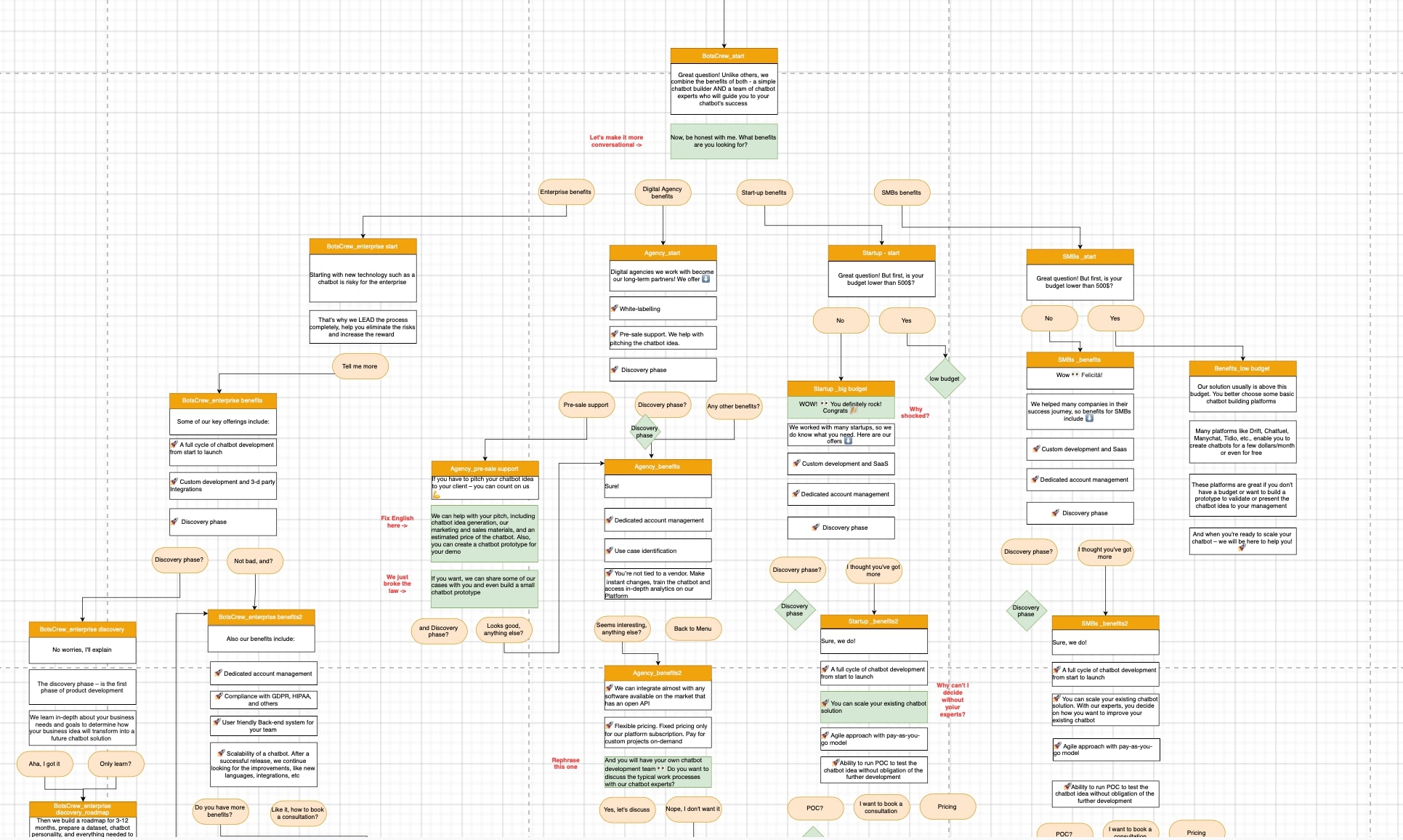
Here we narrow down how the user will communicate with a chatbot. We focus on simplicity when creating a UX design. That way it provides easy navigation, enhanced usability and clear communication to give your users immediate results with minimal effort.
To achieve this navigation simplicity, we need to ask the right questions. The most important question is about the future chatbot's goal. Let’s look at an example.
Case study
Natera, Inc. decided to develop a healthcare chatbot that will assist the company in delivering genetic education. The chatbot would guide and educate patients about genetic testing and help patients get reliable information faster and more conveniently. In addition, it will address patients' needs on multiple products and streamline the customer inquiry process.
So, here the chatbot’s goal is to educate patients about genetic testing and interpret genetic test results.
Based on that, we created a simple diagram that shows how a patient will receive specific information. Here is an example of Welcome message:

In our work process, we usually use the Lucidchart tool that is comfortable for our clients and us. This tool allows us to leave multiple comments, so a conversational designer can quickly adapt the text or conversation logic to the client’s feedback.
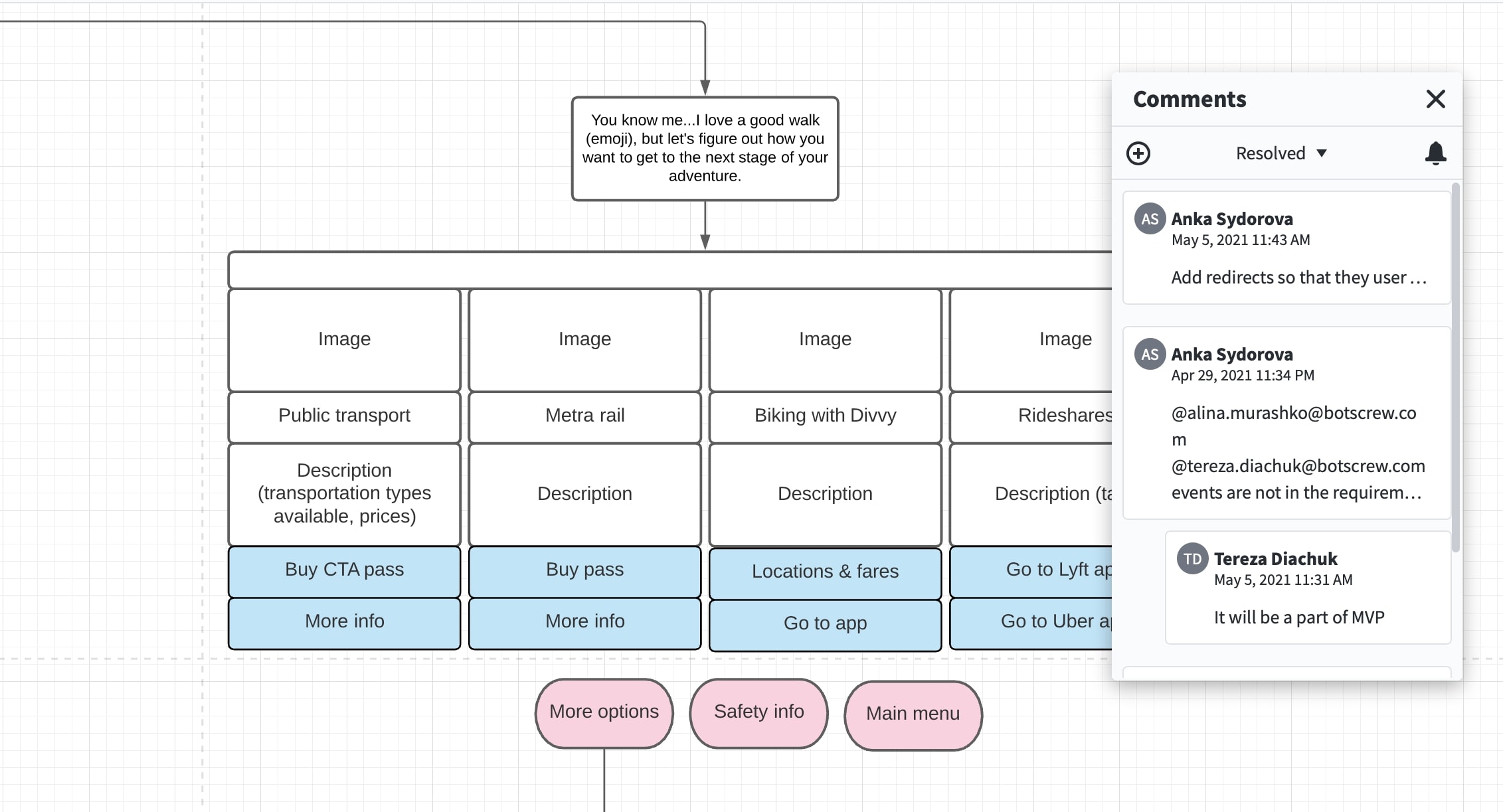
Another common tool is Diagrams.net (formerly known as Draw.io). Despite having limited abilities, it is free, and you can use it to build your own chatbot logic to illustrate your chatbot idea.
Aside from Lucidchart and Diagrams.net, Miro is another tool that can be used for crafting chatbot logic trees. Miro diagram examples are user-friendly and provide an effective visual representation of a chatbot's conversational flow
2. Create a chatbot persona and personality
A chatbot is more than just a script that performs actions. It should create trust between you as a company and your customers. To do so, you should create a chatbot that customers will love to talk with – a chatbot with a defined persona and personality.
Those terms aren’t synonyms. A persona is the set of attributes that define a social role, whereas a personality is the unique combination of emotional and behavioral drivers visible in the way we act. In other words, a persona is like a ”who” while personality is a “how” – how a chatbot will interact with a user.
Chatbot's persona and personality consists of three things. Users+Brand+Purpose. Answering questions about what is the purpose of your chatbot, who will talk with it, and how these conversations communicate your brand values will help you decide on a persona.
Here are some suggestions on how to answer it better:
1. Users
What are your customer segments, and which ones will interact with a chatbot? Talk to your marketing or sales department to get the info of Buyer Persona who regularly purchase your product or service. Based on the Buyer Persona, you can create a chatbot persona that is more likely to connect with your target market.
2. Brand
What is your Brand Equity Model? How should customers think and feel about your product? What is the experience around your brand?
3. Purpose
What is the role of a chatbot? Gathering feedback? Support? Consider what type of human role your bot is simulating.
If a business wants to utilize virtual assistants to augment their sales or support, this bot should be designed in the best possible way to complete a task for the user, deliver something valuable and get the user from point a to point as quickly as possible. Say what you'll do, and do that! Hillary Black, Conversation Designer
Here are questions that will help you decide on a chatbot persona and personality. You don’t have to answer all of these questions, only those you find applicable to your case.
Target audience
Choose a target audience for your chatbot and only after that define the chatbot persona and personality. You can’t design the right personality without knowing your customer.
-
What is the typical age of the target audience of your product?
-
Where do they live?
-
Are there more women or more men or it doesn't matter?
-
What hobbies do you think target users have?
-
What kind of character would your customers accept advice from? Put the name of a person (actor, writer, politician), or a couple of characteristics.
-
When are they going to use your chatbot? How are they likely to be feeling at that moment?
Company brand
Think about the company brand in general:
-
What are the company values?
-
What is the company mission statement?
-
What makes a company unique?
-
What is the company positioning?
Think about visuality:
Do you imagine a chatbot icon more cartoony or more realistic?
Would you like to stick to brand colors for the design, or would you prefer different ones?
If there should be a combination, please describe your vision for chatbot icon, widget, background, chatbot facial expression (if it is like a human), etc.
Think about tone of voice:
-
Do you have specific brand phrases, slogans?
-
What is your brand font?
-
What words do you use to describe the brand experience?
-
How do you communicate what a company is?
-
What do people think of your company now and what do you want them to think in the future?
Chatbot's personality
To define personality, we need a bit of psychology. Usually, we define it through the lens of the Five Factor Model (FFM) or the Big Five. Many contemporary personality psychologists believe that there are five basic dimensions of personality: extraversion (also often spelled extroversion), agreeableness, openness, conscientiousness, and neuroticism. However, you can use this criteria:
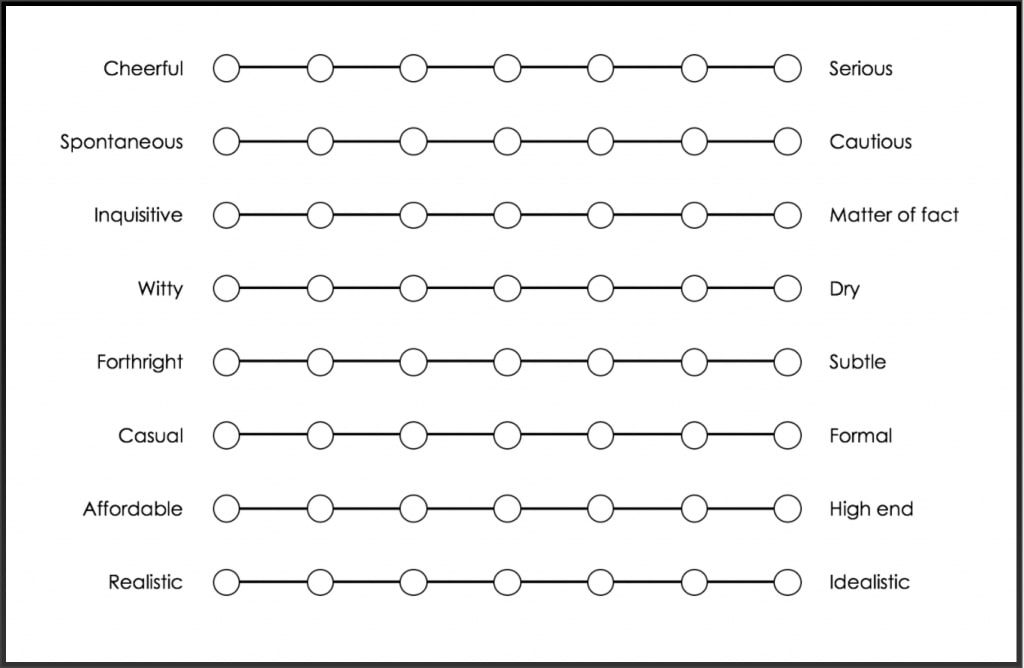
The client or our Designer is choosing the levels of each of criterias above. It will be a basement for creating:
Welcome message (to say hello or start a conversation);
Error message (when the chatbot doesn't understand or fails to complete a request);
Answer to unrelated questions (Do you love me? Are you real? Will you marry me? etc);
Goodbye message; (when a user finish the conversation with a chatbot)
Define the chatbot's purpose
What are the customers’/company’s problems? Define areas that can be possibly automated.
What will the result be? How can we measure it?
What customer data do you need to achieve the results? (name, location, preferences, email, phone number)
What customer data do you have?
How will you use the customer data?
As well, use the framework below.

We aim to make a bot’s persona relevant to the industry that it is made for, so the users would have the feeling they are talking to an expert in the field. Also, we strive to make a сhatbot’s persona clear, simple and entertaining. For example:
Case study
Virgin Holidays is a British company within Sir Richard Branson's Virgin Group. They decided to create a bot that would chat with a user, collect the required info, and then recommend the activity or destination that would be a good match for this person.
The company also wanted the chatbot to talk and sound like a true Californian with their common slang words, expressions, and optimistic vibe. Together with Virgin Holidays and a partner PR company, we created the requirements, ideal user profile, user stories, and a project roadmap. Then, we have moved to the design stage.
With Virgin Holidays, we discussed the chatbot’s tone of voice and flow. Based on the data that Virgin Holidays gave us, we created a friendly, chill, and positive chatbot personality and flow. The chatbot, which Virgin named “Cali- bot” used different emojis and gifs, slang words, and expressions.
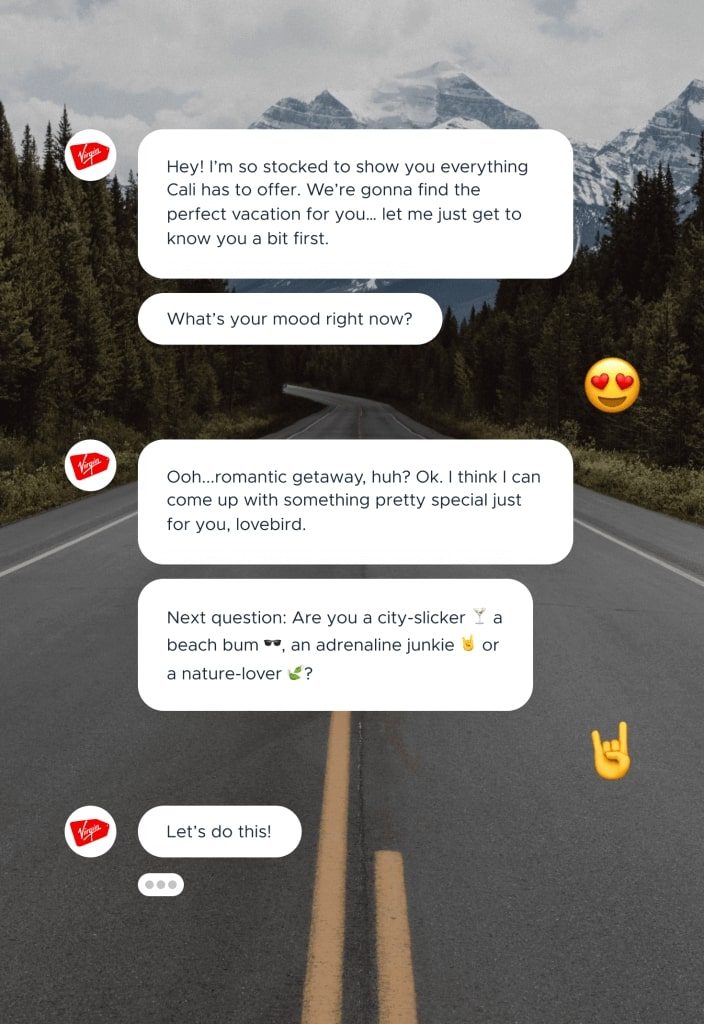
3. Create relevant chatbot’s flow
When you have a diagram, defined chatbot persona and personality, then you can combine all these things, and create chatbot’s flows. In other words, a conversational designer rewrites the first copy of a diagram, making it more adjusted to the chatbot persona’s tone of voice.
When creating the right botsflow, our UX designers make sure that all buttons and replies are placed at the right point of conversation, so the interaction with a bot would be intuitive and logical for every user.
Let’s have a look an example:
Case study
William is a chatbot. He is cheerful, forthright, agreeable, witty, and smart. He has great ability to put thoughts into action, and there is no wait once he sets his mind on something. Where others tend to think or dream, William already takes action while radiating energy, enthusiasm, and livelihood. He is a very ‘back to the point” type of person. So, a chat starts with clear and polite instructions. However, with time after a few interactions, he will be more informal, use friendly (cheerful) language. This has to create a feeling of getting to know somebody as it is with real people.
Here we have a rewritten copy about monitoring of water-miscible coolants, specifically on how to stay safe. And next we have the rewritten copy, how Williams explains it.

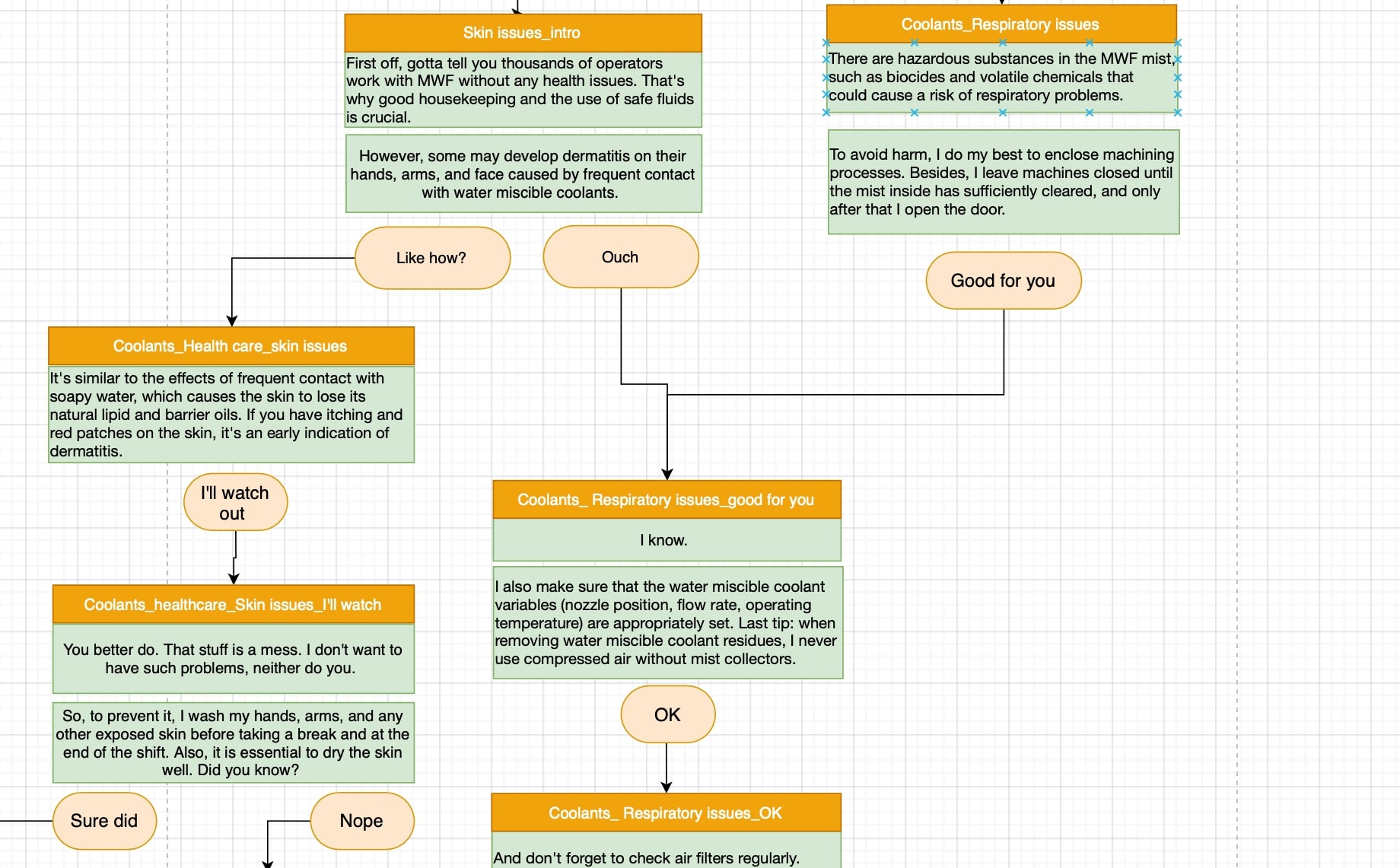
The 5 principles of good conversational UX
Users care when the bot solves their query. A great conversational bot does not require users to type too much, talk too much, repeat themselves several times, or explain things that the bot should automatically know and remember. Quirine van Walt Meijer, Senior Designer in Conversational AI bij Microsoft
There are many things that you have to do to make 110% from a chatbot. But we will start with the basics, what you certainly should keep in mind when discussing your chatbot idea with experts.
1. Don't pretend to be a human
It's annoying for users to discover that they were talking just to a chatbot. Yes, periods are important to create the feeling of real conversation, but if users think they are talking to a real person, the expectations would be very high as well as disappointing. Thus, in the beginning of a conversation, let people know that they are talking to a chatbot.
However, some people don't like or trust that word, so here's what you can use instead: virtual assistant, artificial assistant, conversational tool, etc.
Besides, it's always important (and in some messaging platforms obligatory) to leave an option to talk to a person. So despite the fact that you have to instantly switch from automated flow to Live Chat, it's crucial to mark that transition by design changes. Or you will just confuse users with whom they are talking to.
Here is an example:

Keep it simple. Stating questions and dialog plainly is the easiest way to minimize failure. Even in an NLP-based bot, providing choice options (but listening for other answers) will result in a higher success rate. Hillary Black, Conversation Designer
2. Implement small talk
A chatbot persona and personality is primarily seen in some key messages (Welcome, Goodbye, Error messages). However, in our experience, even under high pressure of not receiving their orders, people tend to write something like: thank you, you're good, okay, you're dumb, etc. Therefore, a chatbot should handle these types of messages to keep the conversation smooth and narrow the user's attention back to the point.

3. Let them go
A user has to have an option of leaving a chat. For example, maybe a chatbot presented information they already know, so there is no need to stay a minute longer. That is why after every portion of information, you have to ask a user their opinion on how a conversation should go.

Follow up. Sometimes life gets in the way! The benefits of chatbots for Messenger and SMS is that you can send re-engagements to customers later on and draw them back into the experience. Recommended Sequence: 3 hours, 24 hours, 3 days, When something changes/you have a new offer for them. Hillary Black, Conversation Designer
4. Show the confirmation
Whenever a user shares some personal information like name, mobile number, email, etc., a chatbot has to confirm that it received the messages. And in some cases, when a chatbot already has the information, it won't ask you again but rather ask for a user's approval.
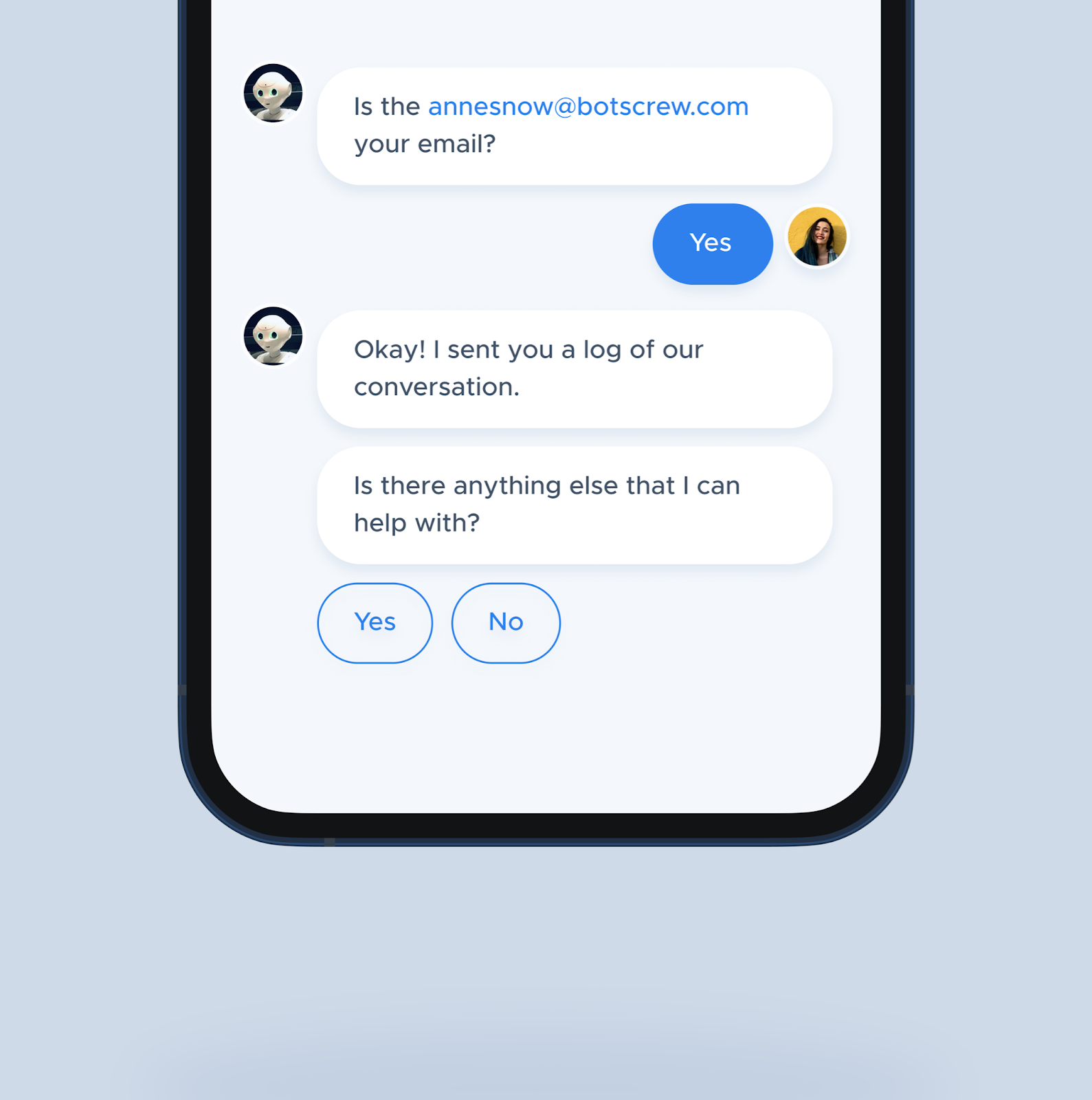
5. The correct endings
If a chatbot finished with the user's request, it has only two options: ask for the new request or ask for feedback.
In the first scenario, it is a simple conversation prolonging. However, in case a person doesn't have any further questions, then you can ask to rate a chatbot with stars or emoji, and provide a comment on how a chatbot can do better next time. Next, you need to find the areas where your chatbot is having trouble with and fix them. Perhaps, the bot wasn't sure how to respond to a situation, or it was not appealing to communicate with for users.

Don't be too open. A user should always know what you want them to do. A blank screen or open ended entry point can be the most intimidating thing for a user! Always state the obvious, guide the user where you want them to go and avoid open ended questions. Hillary Black, Conversation Designer
Summing up
The conversational UX design is a complex but crucial process that defines future chatbot's success. Moreover, depending on the messaging platform (Messenger, App, website, WhatsApp), industry, and purpose of that chatbot, there could be different ways on how you can design communication with artificial assistants.
For further readings, you can check out our article on website chatbots.
And to add a bit of human touch to your chatbot, read our article on how to make automation more personal.








